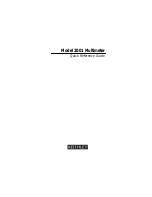
28
4. Taking Measurements
When measuring small resistances the accuracy of the measure-
ment can be adversely influenced by the inherent resistance of the
measuring cables. To identify the inherent resistance, connect the
mass lead with the measuring tip or the crocodile clip on the meas-
uring tip to short out. The displayed value is the inherent resistance
of the cable. This value must be deducted from the total sum to
achieve the correct result.
Make sure that there is good contact between the probes and the
tested object during resistance test. Dirt or other contamination on
the measuring probes or the leads of the resistor may cause incor-
rect readings.
If the measured resistance value exceeds the measuring range
(>20 M
Ω
), the overflow symbol “O.L“ appears in the LC-display.
4.3 Diode Test Function
With this function you can test diodes and other semiconductors for
continuity and blocking function and determine their functionality.
Please note!
While using this function never connect the measuring tip of the unit
and the mass lead with a power source. This may destroy the unit.
Always measure on dead-voltage components or circuitry and
make sure all capacitors are fully discharged before measuring.
Measuring Steps for Diode Test:
1. Make sure the component or circuit is voltage-free. Turn the
measuring tip (1) out of the unit by turning the moving spindle (2)
counter clockwise.
2. Connect the black measuring probe with the measuring tip or with
the Crocodile clip to the COM-Input (13).
3. Turn the rotary function switch (5) to the resistance measuring
mode “
Ω
;
; “. In the display (12) “O.L“ and the scale “M
Ω
“ ap-
pear.
4. Press the button “F-Func.“ once. The symbol “
“ is displayed and
the scale “V“.











































